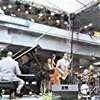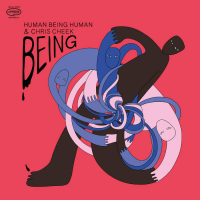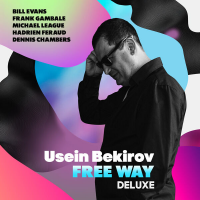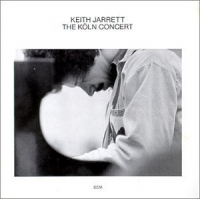Home » Jazz Articles » Album Review » Frances Shelley: A Place That Exists
Frances Shelley: A Place That Exists
Inevitably, these thirteen tracks (sixteen with digital download) have a certain Nyman-esque quality to them, in that they are as much concerned with creating and exploring a series of mood states as with thematic development. The impression is that Shelley begins her improvisations by creating one or two modules which can then be elaborated and varied throughout the piece. In that sense, the harmonies are essentially static with the focus more on the creation of often beautiful, limpid melodies.
Another connection with Nyman and minimalist music more generally is through baroque music. These pieces, like much of Nyman's work, are essentially cyclical in nature, though other influences from French impressionism can also be heard on A Place That Exists, most obviously from Debussy and Ravel.
The term "improvisation" has a different meaning here compared to its use in a jazz context. Shelley's songs function more as a series of preludes or themes created in the moment rather than extemporizations on existing material or free improvisations. In this regard, she and others such as Julie Sassoon and Poppy Ackroyd who work within similar areas are restoring to classical music a lost art. We know, of course, from contemporary accounts that Bach, Mozart, Beethoven, Liszt and Chopin were fine improvisers. For reasons too complex to go into here, the demand for exact replication within industrialized societies later came to replace the desire for spontaneity and unpredictability in performance. This makes Shelley's work all the more valuable.
On the whole, the mood and pacing here is one of quiet reflection which makes it hard to single out particular tracks for reference purposes. A fervent environmentalist and animist, Shelley's music reflects very much the natural world and the gorgeous Suffolk landscape of her home. For those familiar with Suffolk, it is impossible to see that landscape in the mind's eye listening to these pieces. In that way, one inhabits this music as an observer looking out as if through a window onto nature.
Shelley's use of electronics compliments the acoustic piano and her pianistic touch well. Very occasionally, for example on "Star Rush," the washes of electronics sound a little obvious. Elsewhere such as on "Monastere" and "Thaw," Bickerton's contributions are totally apt. A shade more variation of mood and pace might also have been welcome. Both Debussy and Ravel, in particular in their musical responses to the carnage of World War One, were unafraid of more sombre, darker meditations.
However, any such quibbles aside A Place That Exists is an enjoyable listen, a nice place to spend some time and just be.
Frances Shelley talked with Duncan Heining about A Place That Exists.
All About Jazz (AAJ): What inspired you to become a musician? And which other artists and composers have inspired you?
Frances Shelley: When I first heard a piano, country dancing at my village school, I was transfixed. We didn't have much music in our house, just some old 78s. Nobody played an instrument, apart from singing every Sunday in church. I plagued my parents to get me a piano, and then just experimented ... I was so fascinated by the sounds. My first love was the romantics. Schumann, Liszt and, particularly, Chopin took me into another world. I just started copying them... making up my own versions, as I'm lazy and it was quicker than learning to read the notes. Later, I abandoned classical music altogether for many years, as it seemed part of the establishment, school, old people and education, all of which, age 16 and recently expelled from school, I was vehemently rebelling against. I preferred songs for a long time, took up the guitar and wrote many. My heroes were Tracy Chapman, Dylan, the Stones, Aretha Franklin... but it was the Pink Floyd who really opened my ears to sound and what music could be. Dark Side of the Moon (Harvest, 1973) was a transformative moment. Later on when I returned to the piano as my main instrument around 2000, I welcomed the new wave of modern classical music, people like Olafur Arnalds and Nils Frahm, as it gave a genre to the sort of music I was playing already... my piano improvisations, experiments with sound ... ambient, atmospheric music.
AAJ: In your work, you seek to bring together your classical training with improvisation and electronics. How and when did that interest develop?
FS: I think I've always done that. I had bought an old Grundig reel-to-reel taper recorder in an Oxfam shop when I was 13, got riveted by taping my voice, birds, all sorts of strange sounds and playing them back at different speeds. I was never really interested in just re-interpreting someone else's work or good enough to be a concert pianist. The thing that always has got me going was creating something that comes straight out of my heart. I recorded a piano album, Interiors (Self Produced, 2018), really as a means of processing my emotions around my divorce and dysfunctional marriage. It was recorded when I had young children at home, so I didn't have much time and I decided to just sit down and play and record whatever came out, every day for a while. Then I took the best bits and made the whole into an album. I still love that one, it was so cathartic and created out of a desperate need to do something with painful feelings. I've got to thinking that maybe a certain amount of unhappiness or dissatisfaction with life, with oneself, is a gift . . out of which can come beautiful music, it has the power to transmute. I then wanted to take things further, and started using electronics, downloaded Logic, a big step forward and a big learning curve for me and the excitement was huge. I got friends to show me what they knew and, as usual, I experimented. I had always heard multi-layered, orchestral music in my head as I was going about my day but was frustrated that with just one instrument I couldn't reproduce it and I didn't have the patience or organizational skill to write out parts for an orchestra but, at last, I could translate some of this onto an actual recording. This ended up on a couple of tracks on Wilderness Rhapsodies (Self Produced, 2017) my second album and got much more developed on A Place That Exists.
AAJ: As an environmentalist and animal rights campaign, how do these concerns influence the music you make?
FS: I think that the sadness comes through... I hope not too much but people tell me there is always a wistful edge to even my happiest tunes. I am so amazed and glad about the new wave of awareness around factory farming and veganism that is coming about. I think tomorrow's children will look back in horror on factory farming in the same way we now look back on slavery. I'm an animist. I believe that the same life force flows through all creatures and that therefore all creatures deserve equal respect. I don't want to harangue people. Just maybe wake them up a bit. How these concerns influence the music? I think its probably a subtle quality. "A delicate mournfulness," one of my friends called it on the last album.
AAJ: What were your musical aims with A Place That Exists?
FS: My musical aims, mmm? I find this a hard question, as if I'm honest I'm not one of those people who start with a concept and make music towards that end. I'm just not that organized. I just make music because I have to keep sane and well. Like everyone, I need to have some means of expression for my feelings or I literally get sick. When I wrote the album, I was spending a lot of time in Scotland where my aged parents live and I am always in such awe and wonder at the landscape up there. There's this moor called Braco Moor, which features in the artwork on the album cover. It's wild and uninhabited, probably it has looked the same for millions of years, the wind and rain rushing across it. The air smells peaty, fresh, clean. Places like that inspire me, I come home and have to write. The atmosphere of the place is in my mind and I think it colours the music. When I put all the pieces I had made into one collection and looked at them together, it felt that they represented some of my deepest hopes and fears for our beautiful planet. So, the album really is a sort of hymn to the planet, a thankfulness to it and prayer that humans may learn to respect it. The planet will of course survive humanity by a long time, I believe. I chose the title A Place That Exists because even the memory of these places helps me center myself, get things into perspective, if I get caught up in rushing around in my daily life. I believe there are usually parallels to be found between nature and one's own nature. So, I got to thinking there is similarly a "place that exists" within our own souls. Making music is the way that I connect with this place myself, so I guess if I had an aim for the album it would be that others may also experience that connection.
AAJ: How do you see your music developing in the future?
FS: I'm sure I will just keep writing. I think that in any form of art, the real aim is to get a closer spiritual connection, get closer to the source, be more ready to meet my maker when the time comes! If, on the journey, I can reach more people and maybe even help a few on the way, make some changes for good in the world, especially in their relationship with the animal kingdom and with our planet, then I am happy. Let's be realistic too. I'm also planning on seeing my music get some big syncs through Manners McDade, so I can make heaps of money and do some good. That would be okay, too.
Track Listing
Evening Star; Look Up; Thaw; The Unseen Beautiful; The Call; Star Rush; A Place That Exists; Water Music; Blackthorn Tears; Monastere; Snow Drop; For There Is Much To Dare; Trial; Tenderness (download only); Fleeting Sun (download only); Children’s Song (download only).
Personnel
Frances Shelley
pianoAdditional Instrumentation
Bess Cavendish: voice “The Call” only.
Album information
Title: A Place That Exists | Year Released: 2020 | Record Label: Manners Mcdade
Tags
PREVIOUS / NEXT
Support All About Jazz
 All About Jazz has been a pillar of jazz since 1995, championing it as an art form and, more importantly, supporting the musicians who make it. Our enduring commitment has made "AAJ" one of the most culturally important websites of its kind, read by hundreds of thousands of fans, musicians and industry figures every month.
All About Jazz has been a pillar of jazz since 1995, championing it as an art form and, more importantly, supporting the musicians who make it. Our enduring commitment has made "AAJ" one of the most culturally important websites of its kind, read by hundreds of thousands of fans, musicians and industry figures every month.




















